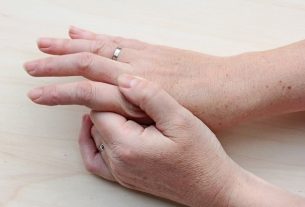Shoulder osteoarthritis is the degeneration of the shoulder joint, which leads to inflammation of the area, resulting in symptoms such as pain in the shoulder when performing certain movements, which increases over the years or intensifies during movements with the shoulders. arms.
Shoulder osteoarthritis can occur due to genetic factors or be a consequence of repetitive or high-impact movements, and it is important that a rheumatologist or orthopedist is consulted so that the diagnosis can be made and the most appropriate treatment can be initiated.
Treatment for shoulder osteoarthritis involves the use of pain-relieving medications, which must be recommended by a doctor, and physiotherapy sessions to improve shoulder mobility. In some cases, surgery may be indicated.

Symptoms of shoulder osteoarthritis
The main symptoms of shoulder osteoarthritis are:
- Pain and swelling in the shoulder, back or top of the shoulder;
- Shoulder stiffness and difficulty moving the arm;
- Feeling of sand in the shoulder joint;
- Cracking in the shoulder while performing the movements.
These symptoms can be constant and more intense when you move your arm, and worsen over time and the pain may even appear at rest.
It is common for shoulder osteoarthritis to occur at the same time as other changes, such as tendonitis or bursitis, which correspond to inflammation of the tissue located inside the shoulder joint. See how to identify and treat shoulder bursitis.
How the diagnosis is made
The diagnosis of osteoarthritis in the shoulder is made by an orthopedist or rheumatologist based on the evaluation of symptoms, health history and physical examination, in which movements involving the shoulder are made to check the person’s mobility, if there is any type of pain and the its intensity.
Make an appointment with an orthopedist in the nearest region:
Taking care of your health has never been easier!
In addition, an X-ray may be requested to evaluate the entire structure of the shoulder and thus be able to check the stage of osteoarthritis, which is important to initiate the most appropriate treatment.
Main causes
The main causes of shoulder osteoarthritis are:
- Genetic factors;
- Natural aging of the body, being more common after the age of 50;
- Chronic rheumatoid arthritis;
- Performing repetitive movements with the arm and shoulder, for sports or profession;
- Direct or indirect trauma to the shoulder, such as falls, dislocated shoulder, or rotator cuff tear.
Shoulder osteoarthritis can most frequently occur in the acromioclavicular joint, located between the clavicle and the shoulder blade (acromion), but it can also affect the glenohumeral joint, between the humerus bone of the arm and the shoulder blade (scapula). See also the causes of acromioclavicular arthrosis.
How the treatment is carried out
The treatment of shoulder osteoarthritis must be carried out under the guidance of a rheumatologist or orthopedist, with the aim of improving and preserving shoulder and arm mobility, and relieving symptoms.
Therefore, the doctor may recommend the use of analgesic and anti-inflammatory medications, such as paracetamol or diclofenac, to relieve pain.
In addition, physiotherapy is also recommended, with the aim of keeping the joint active, in addition to promoting its strengthening and, thus, improving the person’s quality of life. To aid treatment, ice, heat, equipment and even weight training exercises can also be used, but always with the guidance of a physiotherapist.
If the use of medication and/or physiotherapy does not improve symptoms, the doctor can inject a corticosteroid directly into the shoulder joint to reduce inflammation and promote rapid pain relief.
In more serious cases or when other treatments are not enough to alleviate symptoms, the doctor may recommend performing arthroscopy, which is a small surgical procedure to remove bone calluses, and if the case is very serious, replacement of the damaged joint. a prosthesis may be indicated. Understand what shoulder arthroscopy is and what the risks are.
Home treatment for shoulder osteoarthritis
Home treatment for shoulder osteoarthritis can be done with the use of crustacean skeleton-based supplements, recommended by your doctor, as they can help with cartilage recovery. Also discover some home remedies for osteoarthritis.
Bibliography
- PRECERUTTI, M.; et al. Acromioclavicular osteoarthritis and shoulder pain: a review of the role of ultrasonography. J Ultrasound. 23. 3; 317-325, 2020
- ACKERMAN, IN; BUCHBINDER, R. Let’s talk about shoulder osteoarthritis. Rheumatology (Oxford). 61. 9; 3507-3508, 2022
- STANBOROUGH, R. O.; et al. Shoulder Osteoarthritis. Radiol Clin North Am. 60. 4; 593-603, 2022
- VOCELLE, AR; et al. Shoulder structure and function: The impact of osteoarthritis and rehabilitation strategies. J Hand Ther. 35. 3; 377-387, 2022

Sign up for our newsletter and stay up to date with exclusive news
that can transform your routine!
Warning: Undefined array key "title" in /home/storelat/public_html/wp-content/plugins/link-whisper-premium/templates/frontend/related-posts.php on line 12
Warning: Undefined array key "title_tag" in /home/storelat/public_html/wp-content/plugins/link-whisper-premium/templates/frontend/related-posts.php on line 13



